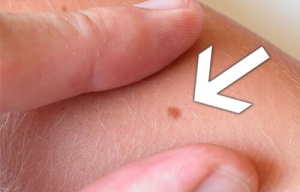How to Identify Dangerous Moles

You can find various cutaneous growths of different colors on your skin (from orange colored tones to dark tones). They might protrude or be flat. These skin growths are called moles. They’re common; knowing which are the dangerous moles is the important part.
Why Worry?
Although moles are common, there are moles that can be dangerous or turn into melanoma (carcinogenic). That is why it is very important to be conscious of your moles and, after reading this article, to look at your skin.
If you find anything unusual, you should see a dermatologist. Among the three ways that skin cancer appears, the most dangerous is melanoma, because it can spread very easily and become very aggressive.
Also, the way this cancer appears is very dangerous based on how it appears on cells that are responsible for giving color to your skin (moles, freckles, birthmarks).
How to Identify Signs of Possible Melanoma
1. Asymmetry: Shapes that Are Uneven.
If you see a mole or birthmark that has an asymmetrical shape in which each half is not equal, this can possibly be melanoma. Why?
It is well known that the majority of moles have a spherical or circular shape, and in general, it is possible that a mole or birthmark that doesn’t have this shape can be dangerous.
2. Size: Not Too Big.
In general, moles can be up to 1 cm in diameter. If one of your moles has a bigger size or if you notice that it is growing, you should pay attention to any changes or go to the dermatologist.
3. A Sudden Mole: Caution!
If a mole suddenly appears on your skin and starts to turn black, you should be very careful and see a dermatologist. It’s very possible that it is malignant.
4. Color: Homogenous Tones.
In the majority of cases, normal moles have a homogenous color that is the same all over: one color dominates. It also tends to look even. If you see many colors on a mole, you should be concerned. It could possibly be a carcinogenic mole.
What to do if you suspect your mole is malignant? Read more:
What is the correct treatment for an abnormal mole?
5. A Mole with these Symptoms: Inflammation, Pain, Blood, or Itch.
In this case, you should be much more attentive to any changes. You should definitely see a dermatologist immediately. These signs can have a strong malignant potential.
6. Edges: Undefined or Irregular.
If the mole doesn’t have a clearly marked beginning or end, or if its edges aren’t well defined, you should also pay attention. It could be a dangerous mole because benign moles are well defined.
7. Family History: Be Careful!
If there has been skin cancer or dangerous moles in your family, it is very important to visit the dermatologist.
Although they know that moles are not hereditary, by keeping in mind that every family shares the same skin type and susceptibility, you should be careful.
Keep on top of your family history to avoid surprises. Learn more:
Is Cancer Hereditary? What You Need to Know
Worried about dangerous moles? We recommend…
In order to avoid malignant marks from appearing, you can prevent them by using sun block frequently, avoiding exposure to direct UV rays, and avoiding the use of products that can threaten your skin. Also, don’t use ultraviolet tanning beds.
Remember…
If after reading this article, you find any of these risk factors or any blemished that look like dangerous moles, see a dermatologist. Time is a highly important factor for undergoing possible treatment.
This text is provided for informational purposes only and does not replace consultation with a professional. If in doubt, consult your specialist.









